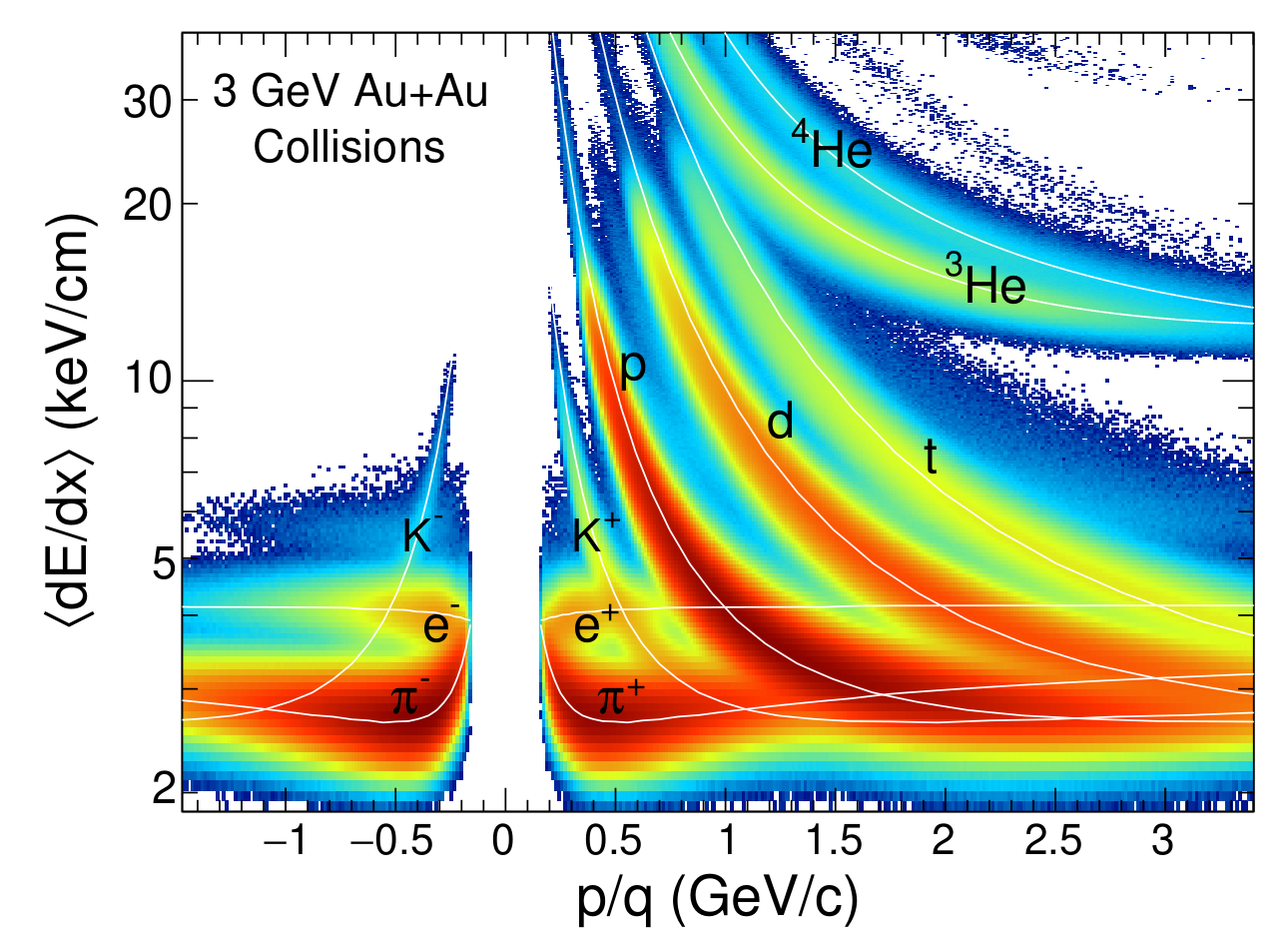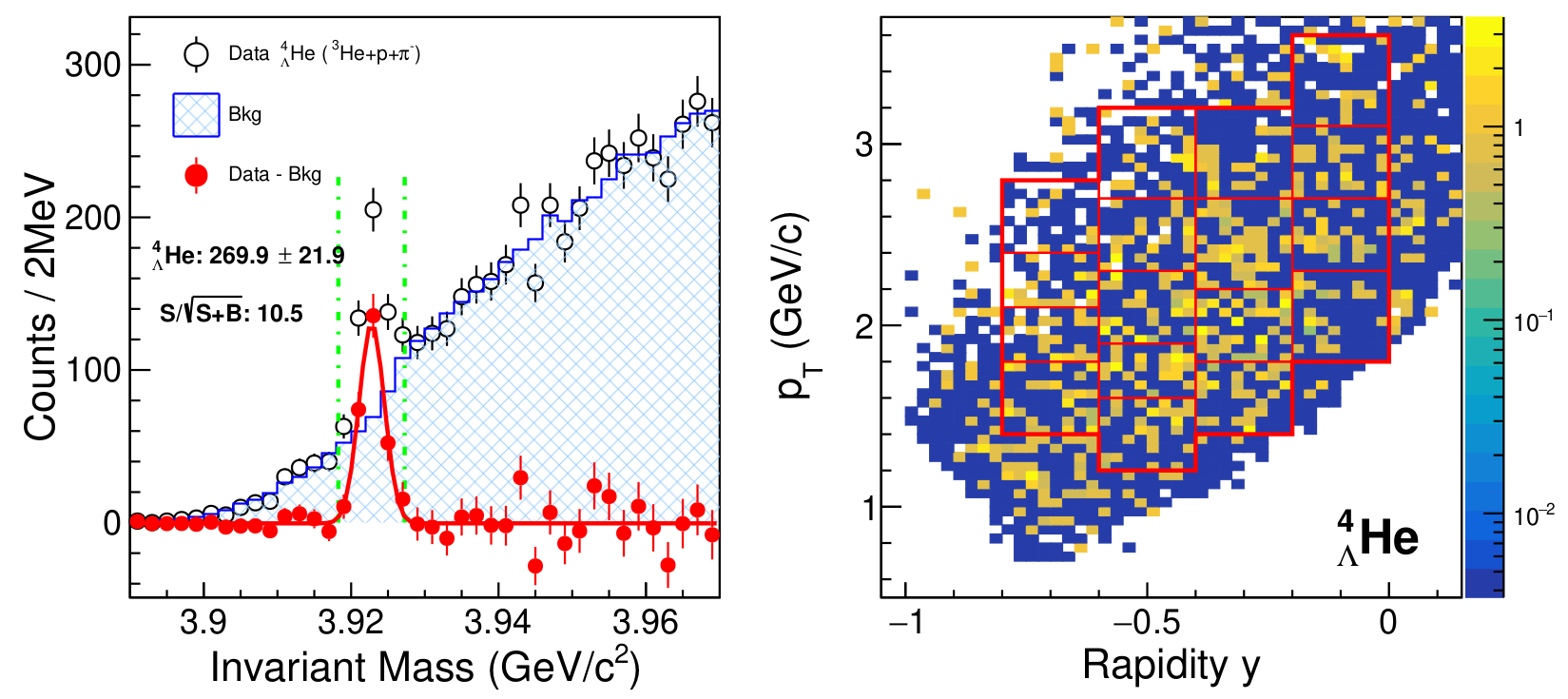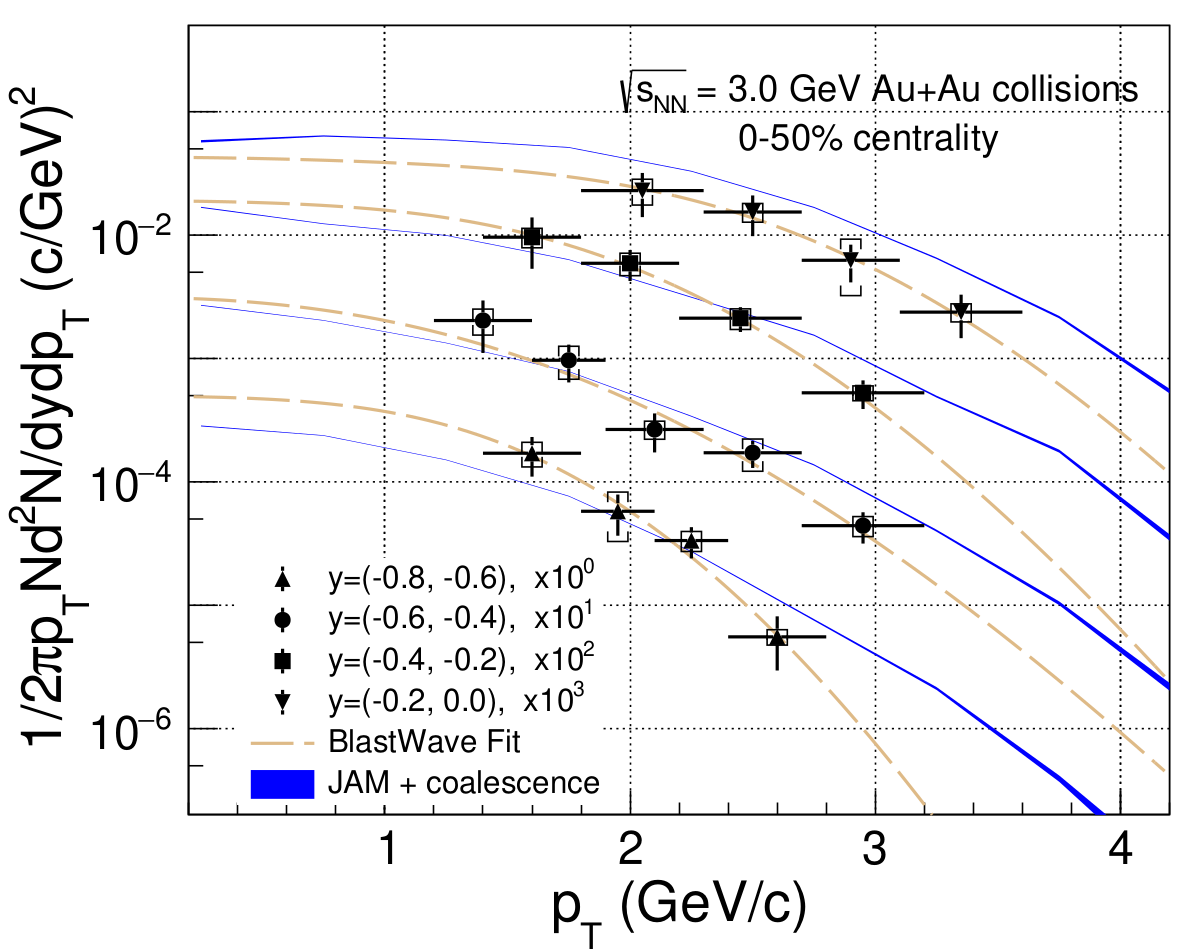Paper proposal: Hyper-Nuclei He4L Production in √s_NN = 3 GeV Au+Au collisions at RHIC
Updated on Tue, 2025-08-05 12:35. Originally created by fzhao on 2024-06-17 04:21.
PAs: L.B. Chen, X.H. He, C.L. Hu, Y.J. Ji, X.J. Li, Y.H. Leung, X.F. Luo, G.N. Xie, N. Xu, Y.P. Zhang, F.Y. Zhao, Y.F. Zhang
https://drupal.star.bnl.gov/STAR/system/files/L4HeProduction_paperDraft_v3_0.pdf
https://drupal.star.bnl.gov/STAR/system/files/L4HeProduction_paperDraft_v4.pdf
https://drupal.star.bnl.gov/STAR/system/files/diff_paperDraft_20250325.pdf
https://drupal.star.bnl.gov/STAR/system/files/L4HeProduction_paperDraft_v5.pdf
https://drupal.star.bnl.gov/STAR/system/files/diff_L4HeProduction_paperDraft_v5-v4.pdf
https://drupal.star.bnl.gov/STAR/system/files/L4HeProduction_paperDraft_v6.pdf
https://drupal.star.bnl.gov/STAR/system/files/diff_L4HeProduction_paperDraft_v6-v5.pdf
Analysis note:
https://drupal.star.bnl.gov/STAR/system/files/He4L_analysisNote.pdf
https://drupal.star.bnl.gov/STAR/system/files/He4L_analysisNote_v2.pdf
Supplemental materials:
PWG Presentations:
https://drupal.star.bnl.gov/STAR/event/2024/03/11/LFSUPC-PWG-meeting/He4L-production-3-GeV-AuAu-Collisions
https://drupal.star.bnl.gov/STAR/system/files/He4L_production_3GeVAuAu_FengyiZhao_20230619.pdf
https://drupal.star.bnl.gov/STAR/system/files/Update_for_He4_%20Production_Analysis_20240520_0.pdfdrupal.star.bnl.gov/STAR/system/files/Reply%20to%20Convener.docx
Collaboration Meeting:
https://drupal.star.bnl.gov/STAR/meetings/STAR-Collaboration-Meeting-March-2024/LFSUPC-Parallel-Session-II/He4L-AuAu-collisions-30-Ge
Paper Proposal on PWG
https://drupal.star.bnl.gov/STAR/system/files/fzhao_He4LProduction_20240422_PaperProposal.pdf
PWGC Review:
https://drupal.star.bnl.gov/STAR/system/files/fzhao_He4LProduction_20240415_PWGC_v4.pdf
Reply to PWGC comments:
https://drupal.star.bnl.gov/STAR/system/files/PWGC_QA.pdf
Reply to PWG conveners:
https://drupal.star.bnl.gov/STAR/system/files/L4HeProduction-diff_0.pdf
https://drupal.star.bnl.gov/STAR/system/files/Reply%20to%20Convener.docx
GPC presentation:
https://drupal.star.bnl.gov/STAR/system/files/He4L_production_GPC390_20250325.pdf
Target journal: Chinese Physics C
Bookmarks: Abstract Figures Paper draft Note Supplemental materials
Abstract:
Hypernuclei, bound states of nuclei with one or more hyperons, serve as a natural laboratory to investigate the hyperon-nucleon interaction. Hypernuclei production in heavy-ion collisions at high-baryon density region, shall provide valuable information for studying hyper-cluster formation mechanism. In Au+Au collisions at √s_NN = 3 GeV preformed by the STAR experiment, hyper-nuclei He4L are identified by its three-body decay channel, i.e He4L->3He +p+π-, and He4L yield as a function of rapidity and transverse momentum in 0-50% centrality are measured for first time. We found that yields of He4L along the rapidity are overall lower than these of H4L, and differential yield ratios of He4L/H4L are consistent with these of He3/t within uncertainties. The observed yield ratios can be described by both the JAM plus an afterburner coalescence and canonical thermal model.
Proposed figures:

Figure 1: Rigidity (p/q) verses energy loss ⟨dE/dx⟩ obtained with the TPC detector in √s_NN = 3.0 GeV Au+Au collisions, lines represents the Bichsel functions for different particle species.

Figure 2: (Left panel) Invariant mass of He3+p+pi distributions from √s_NN = 3.0 GeV Au+Au collisions. Open circle and filled-red-circles are raw data and background subtracted distributions, respectively; (right panel) Acceptance of the He4L raw yields shown in transverse momentum pT vs. rapidity y.

Figure 3: Transverse momentum distributions d2N/pTdydpT of He4L from 0-50\% central √s_NN=3.0 GeV Au+Au collisions. Data points from four rapidity bins are shown. Blast-wave fit results are shown as dashed-lines while the JAM plus afterburner coalescence model results are shown as blue bands.


Figure 4: (Left panel) Rapidity dependence of the He4L yields (filled-black-circle) from 0-50% central √s_NN = 3.0 GeV Au+Au collisions; (right panel) Rapidity dependence of the averaged transverse momentum <pT> of He4L. For comparison, the results of H4L are also shown as black triangles. Model calculations from JAM plus afterburner coalescence are shown as dash line and dotted lines for He4L and H4L, respectively.



Figure 5: Rapidity dependence of the yield ratio for He4L/H4L (filled circle) and He3/t (open triangle) from the 0-50% √s_NN = 3.0 GeV Au+Au collisions. Both yield ratios given by the
JAM model plus afterburner coalescence are shown as dotted line and dotted line . Yield ratios of He4L/H4L and He3/t given by the thermal model are shown by blue and green lines, respectively.
Conclusions:
Bookmarks: Abstract Figures Paper draft Note Supplemental materials
Abstract:
Hypernuclei, bound states of nuclei with one or more hyperons, serve as a natural laboratory to investigate the hyperon-nucleon interaction. Hypernuclei production in heavy-ion collisions at high-baryon density region, shall provide valuable information for studying hyper-cluster formation mechanism. In Au+Au collisions at √s_NN = 3 GeV preformed by the STAR experiment, hyper-nuclei He4L are identified by its three-body decay channel, i.e He4L->3He +p+π-, and He4L yield as a function of rapidity and transverse momentum in 0-50% centrality are measured for first time. We found that yields of He4L along the rapidity are overall lower than these of H4L, and differential yield ratios of He4L/H4L are consistent with these of He3/t within uncertainties. The observed yield ratios can be described by both the JAM plus an afterburner coalescence and canonical thermal model.
Proposed figures:

Figure 1: Rigidity (p/q) verses energy loss ⟨dE/dx⟩ obtained with the TPC detector in √s_NN = 3.0 GeV Au+Au collisions, lines represents the Bichsel functions for different particle species.

Figure 2: (Left panel) Invariant mass of He3+p+pi distributions from √s_NN = 3.0 GeV Au+Au collisions. Open circle and filled-red-circles are raw data and background subtracted distributions, respectively; (right panel) Acceptance of the He4L raw yields shown in transverse momentum pT vs. rapidity y.

Figure 3: Transverse momentum distributions d2N/pTdydpT of He4L from 0-50\% central √s_NN=3.0 GeV Au+Au collisions. Data points from four rapidity bins are shown. Blast-wave fit results are shown as dashed-lines while the JAM plus afterburner coalescence model results are shown as blue bands.

Figure 4: (Left panel) Rapidity dependence of the He4L yields (filled-black-circle) from 0-50% central √s_NN = 3.0 GeV Au+Au collisions; (right panel) Rapidity dependence of the averaged transverse momentum <pT> of He4L. For comparison, the results of H4L are also shown as black triangles. Model calculations from JAM plus afterburner coalescence are shown as dash line and dotted lines for He4L and H4L, respectively.


Figure 5: Rapidity dependence of the yield ratio for He4L/H4L (filled circle) and He3/t (open triangle) from the 0-50% √s_NN = 3.0 GeV Au+Au collisions. Both yield ratios given by the
JAM model plus afterburner coalescence are shown as dotted line and dotted line . Yield ratios of He4L/H4L and He3/t given by the thermal model are shown by blue and green lines, respectively.
Conclusions:
- Production of He4L are measured via both 3-body decay channel in √s_NN = 3 GeV Au+Au collisions at RHIC.
- Yields of He4L along the rapidity are overall consistent with these of H4L within 1 sigma uncertainties, except for the middle rapidity region -0.2<y<0, which is 2.4 sigma lower than the yield of H4L. Yield ratios of He4L/H4L are consistent with that of He3/t within uncertainties.
- With the same coalescence parameters for He3-Λ and t-Λ, calculations from the transport model JAM plus coalescence afterburner can reproduce both the yield and mean pT distributions for He4L and H4L, as well as the He4L/H4L and 3He/t yields ratios. Thermal-fist predictions with Tcℎ=85MeV and μB=727.9MeV can reasonably describe both ratios.
https://drupal.star.bnl.gov/STAR/system/files/L4HeProduction_paperDraft_v3_0.pdf
https://drupal.star.bnl.gov/STAR/system/files/L4HeProduction_paperDraft_v4.pdf
https://drupal.star.bnl.gov/STAR/system/files/diff_paperDraft_20250325.pdf
https://drupal.star.bnl.gov/STAR/system/files/L4HeProduction_paperDraft_v5.pdf
https://drupal.star.bnl.gov/STAR/system/files/diff_L4HeProduction_paperDraft_v5-v4.pdf
https://drupal.star.bnl.gov/STAR/system/files/L4HeProduction_paperDraft_v6.pdf
https://drupal.star.bnl.gov/STAR/system/files/diff_L4HeProduction_paperDraft_v6-v5.pdf
Analysis note:
https://drupal.star.bnl.gov/STAR/system/files/He4L_analysisNote.pdf
https://drupal.star.bnl.gov/STAR/system/files/He4L_analysisNote_v2.pdf
Supplemental materials:
PWG Presentations:
https://drupal.star.bnl.gov/STAR/event/2024/03/11/LFSUPC-PWG-meeting/He4L-production-3-GeV-AuAu-Collisions
https://drupal.star.bnl.gov/STAR/system/files/He4L_production_3GeVAuAu_FengyiZhao_20230619.pdf
https://drupal.star.bnl.gov/STAR/system/files/Update_for_He4_%20Production_Analysis_20240520_0.pdfdrupal.star.bnl.gov/STAR/system/files/Reply%20to%20Convener.docx
Collaboration Meeting:
https://drupal.star.bnl.gov/STAR/meetings/STAR-Collaboration-Meeting-March-2024/LFSUPC-Parallel-Session-II/He4L-AuAu-collisions-30-Ge
Paper Proposal on PWG
https://drupal.star.bnl.gov/STAR/system/files/fzhao_He4LProduction_20240422_PaperProposal.pdf
PWGC Review:
https://drupal.star.bnl.gov/STAR/system/files/fzhao_He4LProduction_20240415_PWGC_v4.pdf
Reply to PWGC comments:
https://drupal.star.bnl.gov/STAR/system/files/PWGC_QA.pdf
Reply to PWG conveners:
https://drupal.star.bnl.gov/STAR/system/files/L4HeProduction-diff_0.pdf
https://drupal.star.bnl.gov/STAR/system/files/Reply%20to%20Convener.docx
GPC presentation:
https://drupal.star.bnl.gov/STAR/system/files/He4L_production_GPC390_20250325.pdf
https://drupal.star.bnl.gov/STAR/system/files/Major%20Comments%20on%20GPC%20Meeting%202025_0.pdf
GPC comments:
https://drupal.star.bnl.gov/STAR/system/files/L4HeProduction_paperDraft_v5_syang_0_0.pdf
https://drupal.star.bnl.gov/STAR/system/files/GPC_390-comments_7_2_Videbaek.docx
»
- fzhao's blog
- Login or register to post comments
